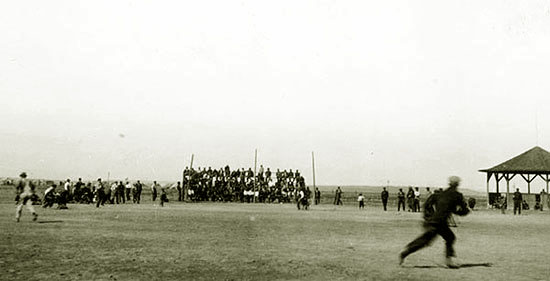
Baseball Game at Ludlow, 1914. See text below.
In 1913 and 1914, a series of events occured in Southern Colorado which ultimately had a major impact on Wyoming and, indeed,
on mining throughout the Rocky Mountain West. Beginning in the 1890's, the United Mine Workers began to organize the mining camps of
Southern Colorado and Northern New Mexico. Conditions in the mines owned by Colorado Fuel and Iron Company ("C. F. & I.") were abysmal. In Wyoming the
C. F. & I owned the Sunrise iron ore mine near Hartville, not involved in the strike. The Company also at one time had industrial interests
in Laramie and owned the Colorado and Southern Railroad used to bring iron ore from Wyoming to the Company's main
smelter in Pueblo. C. F. & I. miners were paid by tonnage mined. The Company would cheat in the scales. Notwithstanding Colorado law making illegal payment of wages in
Company scrip redeemable only at the Company Store, Colorado mines persisted in the practice. The rental of the
company houses returned to the Company 6 to 8% on investment. Workers were not paid for time expended
in shoring up the galleries or installing tram track ("Dead work"). The cost of black powder using in the mining
of the face was deducted from their pay as was the cost of blacksmithing on the
tools. A series of unsuccessful strikes hit the Colorado and New Mexico mines. Miners struck in Gallup, N. Mex. in 1900;
and in Colorado in 1903, 1904, and 1910. On September 23, 1913, over 12,000 miners in sourthern
Colorado went on strike. The demands were simple. Many of the demands were already required by Colorado law, but the law was ignored by C. F. & I.
The union demands:
:
 Recognition of the U.M.W.; Recognition of the U.M.W.;
 A 10% increase in tonnage rates to equal those of miners in Wyoming; A 10% increase in tonnage rates to equal those of miners in Wyoming;
 Election of their own weighmen to weigh the tonnage; Election of their own weighmen to weigh the tonnage;
 Payment for "dead work;" Payment for "dead work;"
 An eight-hour day; An eight-hour day;
 The right to trade at other than the Company store and to reside where they chose; The right to trade at other than the Company store and to reside where they chose;
 Enforcement of Colorado mining laws (Colorado had twice the fatality rate as the
rest of the Country) and abolishment of a system of private security utilized by the
Company. Enforcement of Colorado mining laws (Colorado had twice the fatality rate as the
rest of the Country) and abolishment of a system of private security utilized by the
Company.
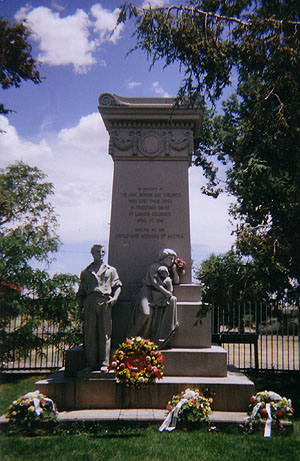 United Mine Workers monument to those
killed at Ludlow, Colorado. Photo by Geoff Dobson, 2008. United Mine Workers monument to those
killed at Ludlow, Colorado. Photo by Geoff Dobson, 2008.
In response, the miners were evicted from the Company-owned houses and C. F. & I. brought in a
private security firm who utilized an armored car affixed with a
machine gun. On October 17, 1913, the car, known as the "Death Special," was used at
Forbes, Colorado, to spray with bullets a tent city in which the miners and their families were
dwelling. One tent was found to have 148 bullet holes. One miner was killed and a child was shot.
As if to prove the Union's concern about mine safety, on October 22 at 3:00 p.m., an explosion in a Phelps-Dodge Mine in
Dawson, N. Mex. killed 261 miners. A tongue of flame shot out 100 feet from the mine mouth. The force of the
explosion shook houses two miles away. Subsequent investigation revealed that dynamite used in violation of
Bureau of Mines standards set off an explosion of coal dust. The Bureau also recommended that
dust be kept down with a water spray and rock dust. Neither had been done. Ten years later another 120 were killed in Dawson.
Again water sprays were not used. In 1950, Phelps Dodge closed the town and evicted all of the residents on 30 days
notice. The town was razed and nothing remains except the cemetery.
The strike continued. The governor of Colorado, at the
request of the Company, called out the Colorado National Guard. Company "guards" were sworn into the
Colorado National Guard. Eighteen miles north of Trinidad at Ludlow, the Union established a tent town occupied by over 900. The miners
constructed a school, a stage for emtertainment and a baseball field. On April 19, 1914, the miners played a
baseball game. The game was interrupted by members of the National Guard riding onto the field.
The next day, the town was attacked by the
National Guard who burned the town down. In the smoldering ruins 23 miners, women and children were found dead.
Some had taken refuge in a hole later known as the
"death pit."
The bodies of three miners lay alongside the railroad tracks for passengers on
the trains to view. For three days, the National Guard would
not allow the bodies to be removed. One miner, Louis Tikas, had a fractured skull from having been clubbed by
Lt. Karl E. Linderfelt with a Springfield rifle. Tikas was then shot as he lay dying on the ground.
Eighty-four year old, Mother Jones, Mary Harris Jones (1830-1930),
the famous turn of the century reformist, traveled to Trinidad
where she was arrested and held
incommunicato by the Colorado Guard.
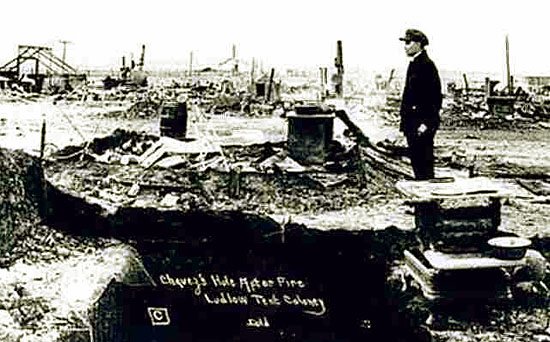
The Death Pit, Ludlow, Colorado, 1914.
Mother Jones in her autobiography described the events at Ludlow:
On the 19th of April, 1914, machine guns, used on the strikers in the
Paint Creek strike, were placed in position above the tent colony of
Ludlow. Major Pat Hamrock and Lieutenant K. E. Linderfelt were in charge
of the militia, the majority of whom were, company gun-men sworn in as
soldiers.
Early in the morning soldiers approached the colony with a demand
from headquarters that Louis Tikas, leader of the Greeks, surrender
two Italians. Tikas demanded a warrant for their arrest. They had none.
Tikas refused to surrender them. The soldiers returned to quarters.
A signal bomb was fired. Then another. Immediately the machine guns
began spraying the flimsy tent colony, the only home the wretched families
of the miners had, riddling it with bullets. Like iron rain, bullets'
upon men, women and children.
The women and children fled to the hills. Others tarried. The men
defended their home with their guns. All day long the firing continued.
Men fell dead, their faces to the ground. Women dropped. The little Snyder
boy was shot through the head, trying to save his kitten. A child carrying
water to his dying mother was killed.
By five o'clock in the afternoon, the miners had no more food, nor
water, nor ammunition. They had to retreat with their wives and little
ones into the hills. Louis Tikas was riddled with shots while he tried to
lead women and children to safety. They perished with him.
Night came. A raw wind blew down the canyons where men, women and
children shivered and wept. Then a blaze lighted the sky. The soldiers,
drunk with blood and with the liquor they had looted from the saloon, set
fire to the tents of Ludlow with oil-soaked torches. The tents, all the
poor furnishings, the clothes and bedding of the miners' families burned.
Coils of barbed wire were stuffed into the well, the miners' only water
supply.
After it was over, the wretched people crept back to bury their
dead. In a dugout under a burned tent, the charred bodies of eleven
little children and two women were found-unrecognizable. Everything
lay in ruins. The wires of bed springs writhed on the ground as if they,
too, had tried to flee the horror. Oil and fire and guns had robbed men
and women and children of their homes and slaughtered tiny babies and
defenseless women. Done by order of Lieutenant Linderfelt, a savage, brutal
executor of the will of the Colorado Fuel and Iron Company.
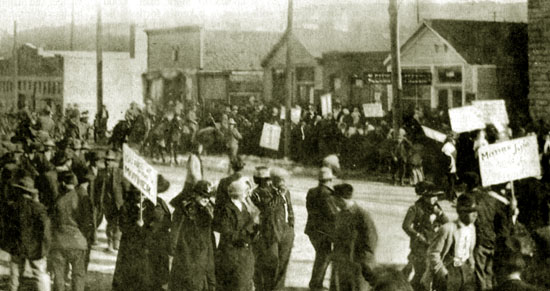
Protesters asking for release of Mother Jones, Commercial
Street, Trinidad, Colorado, 1914.
Among those who came to support the miners after the disaster was Margaret Tobin (Mrs. J. J.) Brown.
[Writer's note: Mrs. Brown is now commonly referred to as "Molly Brown." She is noted for her efforts on behalf of
those impoverished by the death of breadwinners in the sinking of the Royal Mail Ship Titanic. Before leaving the
Carpathia she had raised $10,000 on their behalf. There is no indication that during her
lifetime she was referred to as "Molly." The name apparently originated with the
Denver Post following her death. A guide at the "Molly Brown" House in Denver indicates that the
name Molly came from the musical.]
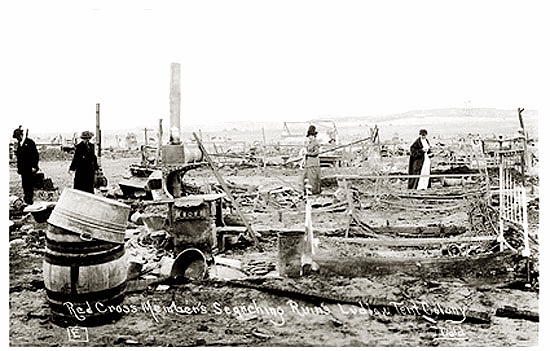
Red Cross workers searching ruins of Ludlow tent
colony, April 23, 1914.
The strike continued on into 1915 and finally ended with Congressional Investigations at which
Rockefeller was required to testify. He denied there was any massacre.
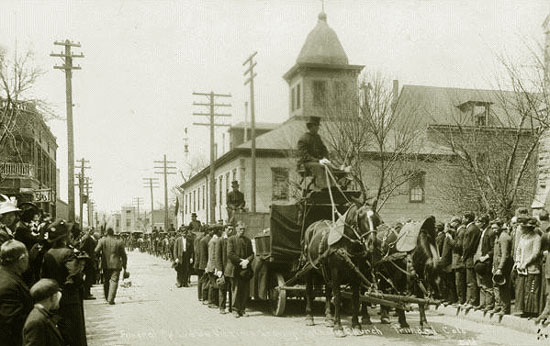
Caskets of the dead on hay wagons arriving at Holy Trinity Church, Trinidad, Colorado. Photo by L. Dodd,
1914.
The strike fizzled out with the miners
either going back to work or moving as many did to Utah and Wyoming and taking employment in mines owned by
the Union Pacific Coal Company. In Colorado, the UMW did not gain recognition until the
1930's. Instead, Rockefeller's company organized a Company dominated union. Thus, in one sense, the strike was a
failure for the miners. For Rockefeller, the massacre was a disaster. He was faced with almost universal condemnation.
Harper's Weekly ran an editorial cartoon depicting Rockefeller as a vulture hanging over the devastation of Ludlow.
The cartoon bore the caption "Success."
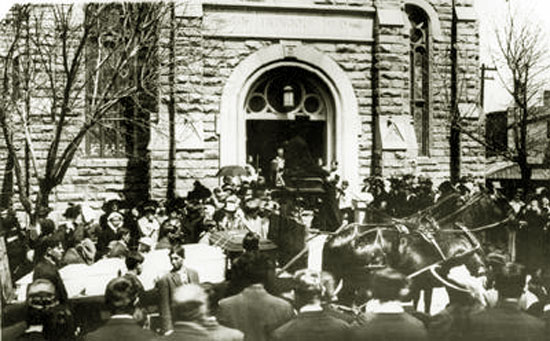
Funeral Cortege Ludlow victims, Holy Trinity Church, Trinidad, Colorado. Photo by L. Dodd, 1914.
To overcome the public infamy that his heavy-handedness and perceived wickedness in bringing down the
strike had wrought, Rockefeller employed Ivy L. Lee, publicist for the Pennsylvania Railroad, to rehabilitate his image with public philanthropy.
But in another and larger sense, it brought needed reforms to
the Colorado mining fields and brought to Wyoming many of the families who today continue
to reside in the state. Rockefeller's newly found philanthropy brought to Wyoming the
Teton National Park and resulted in Sunrise being made into a model town. Although Sunrise was an
iron ore mining camp, it was similar to many of the Coal Camps.
On Memorial Day 1918 in the shadows of the Sangre de Cristo Mountains
near the site of the death pit, the United Mine Workers dedicated a memorial
to some of those killed at Ludlow. On the memorial is a plaque:
VICTIMS OF
LUDLOW MASSACRE
APRIL 20, 1914
LOUIS TIKAS, AGE 30 YRS.
JAMES FYLER, AGE 43 YRS.
JOHN BARTOLOTTI, AGE 45 YRS.
CHARLIE COSTA, AGE 31 YRS.
FEDELINA COSTA, AGE 27 YRS.
ONAFRIO COSTA, AGE 6 YRS.
LUCY COSTA, AGE 4 YRS.
FRANK RUBINO, AGE 23 YRS.
PATRIA VALDEZ, AGE 37 YRS.
EULALA VALDEZ, AGE 8 YRS.
MARY VALDEZ, AGE 7 YRS.
ELVIRA VALDEZ, AGE 3 MO.
JOE PETRUCCI, AGE 4 1/2 YRS.
LUCY PERTUCCI, AGE 2 1/2 YRS.
WILLIAM SNYDER, JR., AGE 11 YRS.
RODGERLO PEDREGONE, AGE 6 YRS.
CLORIVA PEDREGONE, AGE 4 YRS.
|
Sometime on May 7 or May 8, 2003, the Memorial was vandalized. Heads of statues of miners
were broken off and removed. Other damage occurred. The culprits have never been
identified. The damage has now been repaired and the memorial is now behind a steel barrier. Surrounding the
inner enclosure is a chain link fence within which, on the day the writer visited, was a large
sheep dog who came out to greet visitors.
Lt. Linderfelt (1876-1957) was court martialed on charges of murder, assault with a deadly weapon, and
grand larceny of $350.00 belonging to Louis Tikas. The Court found he had committed the assault on
Tikas, "but attached no criminality thereto. And the Court therefore aquit him." Linderfelt died in
1957 and was interred in a place of honor, the Los Angeles National Cemetery. ,p>
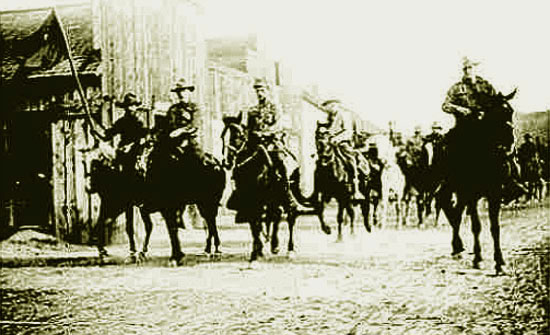
National Guardsmen, Forbes, Colorado, Karl E. Linderfelt on right. 1914.
In 1997, the Colorado Supreme Court cited the events at Ludlow in support of the general proposition
that a man's home, no matter how humble, even a tent, is free from warrentless search. See
People v. Schefer, 946 P. 2d 938 (Colo. 1997).
Music this page:
We're Coming, Colorado
(Sung to the tune of Battle Cry of Freedom)
Words by Frank J. Hayes
I.
We will win the fight today, boys,
We'll win the fight today,
Shouting the battle cry of union;
We will rally from the coal mines,
We'll battle to the end,
Shouting the battle cry of union.
CHORUS:
The union forever, hurrah, boys, hurrah!
Down with the Baldwins, up with the law;
For we're coming, Colorado, we're coming all the way,
Shouting the battle cry of union.
II
We have fought them here for years, boys,
We'll fight them in the end,
Shouting the battle cry of union.
We have fought them in the North,
Now we'll fight them in the South,
Shouting the battle cry of union.
REPEAT CHORUS
III
We are fighting for our rights, boys,
We are fighting for our homes,
Shouting the battle cry of union;
Men have died to win the struggle;
They've died to set us free,
Shouting the battle cry of union.
REPEAT CHORUS
Writer's notes: Baldwin's, the Baldwin Felts
Detective Agency, hired by C. F. & I. to
break the strike. Frank J. Hayes, Vice President of the United Mine Workers, later President.
Next Page: Superior.
|